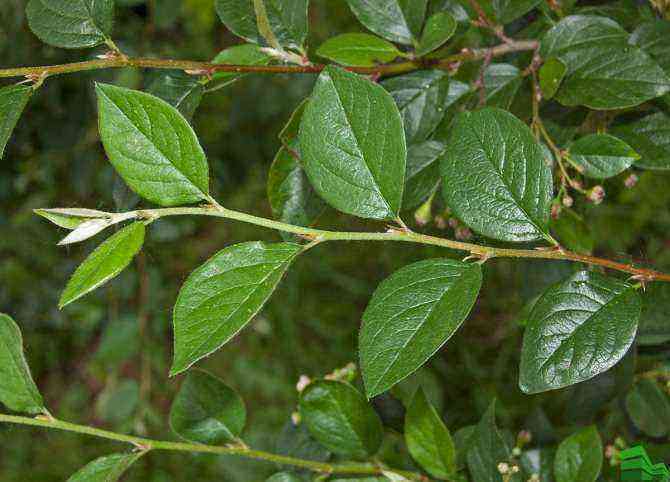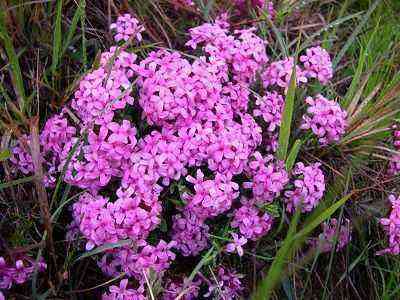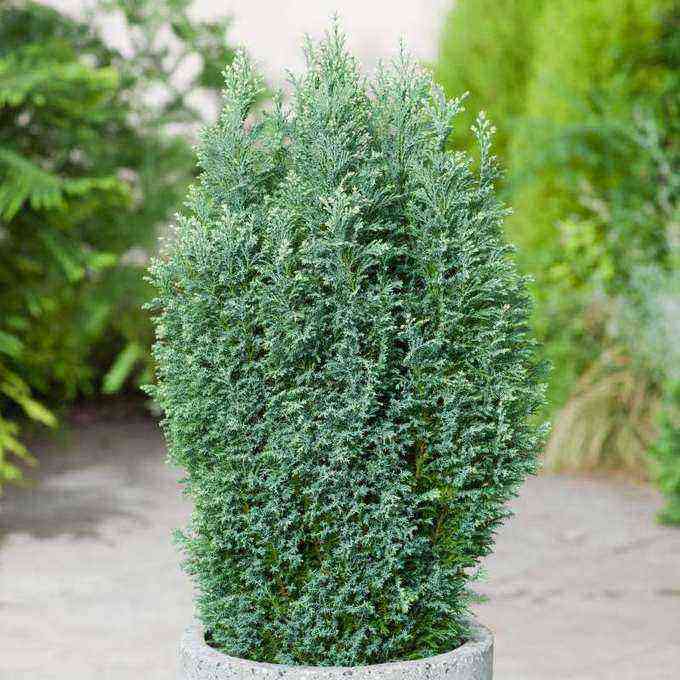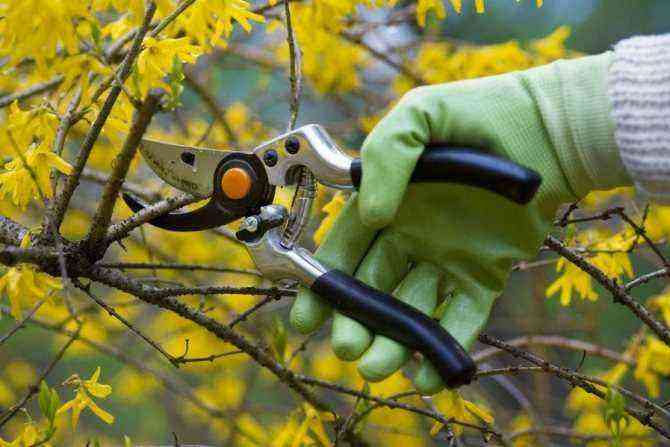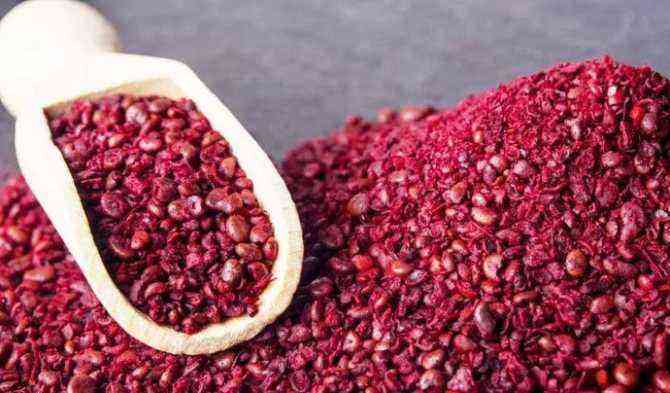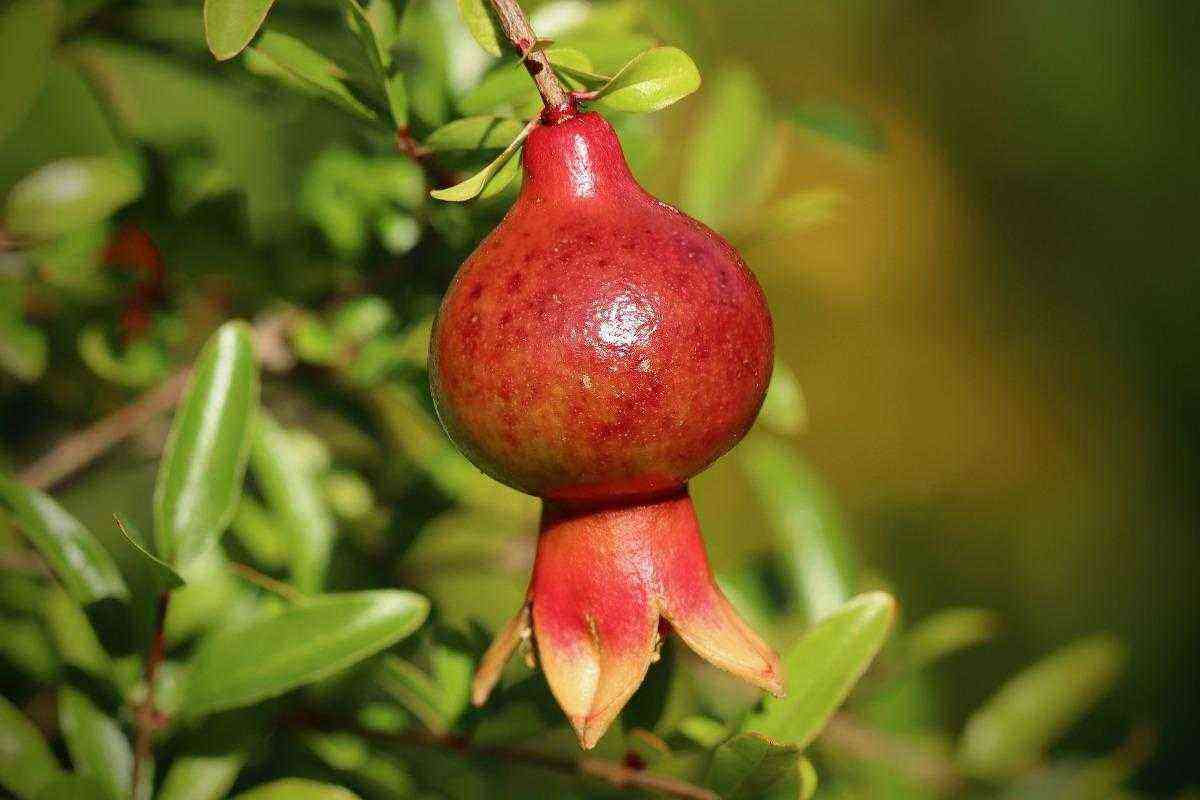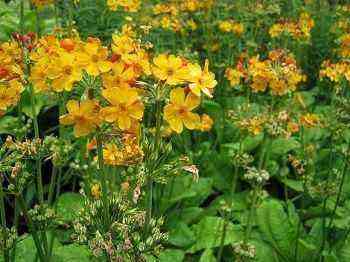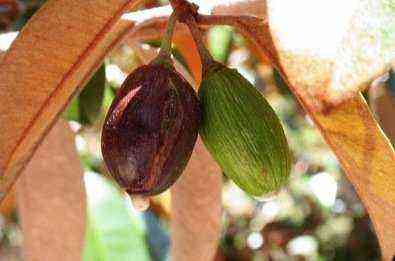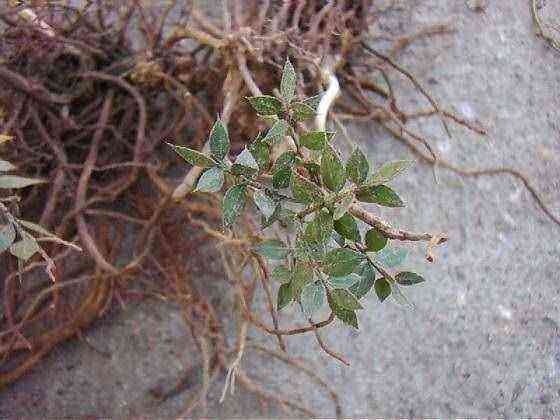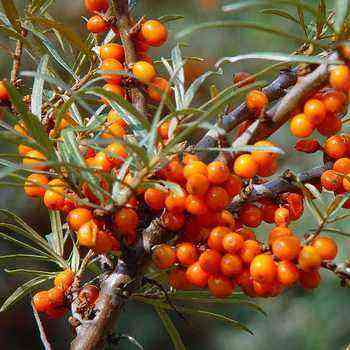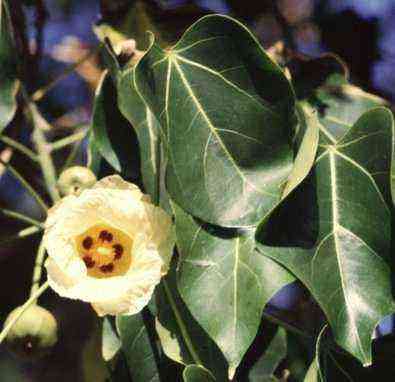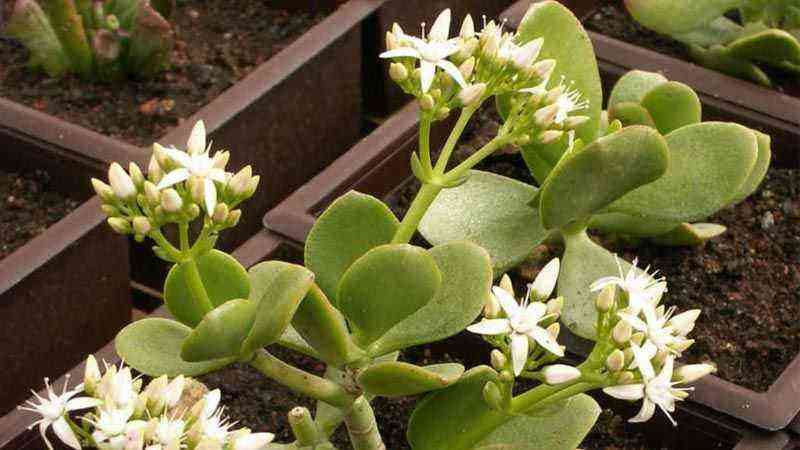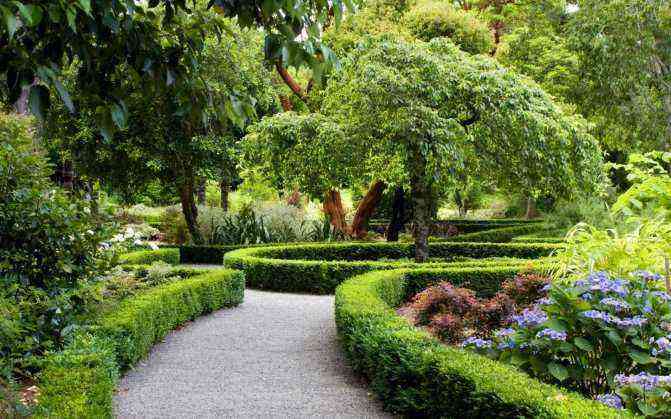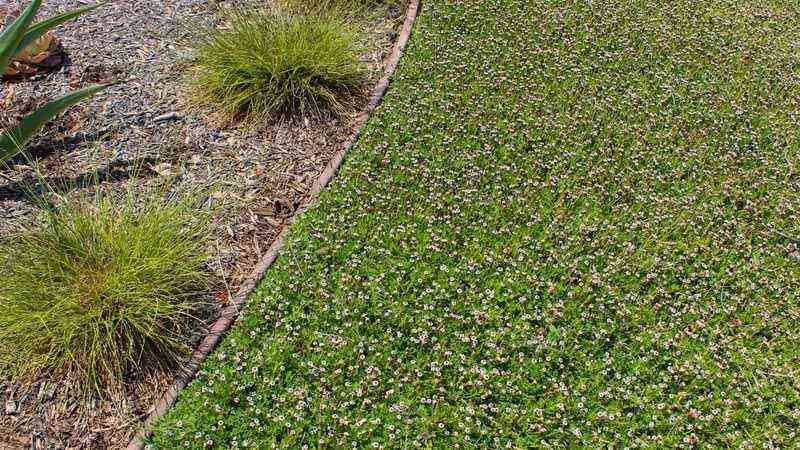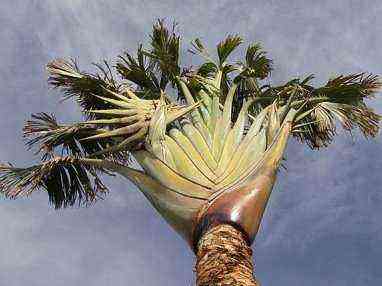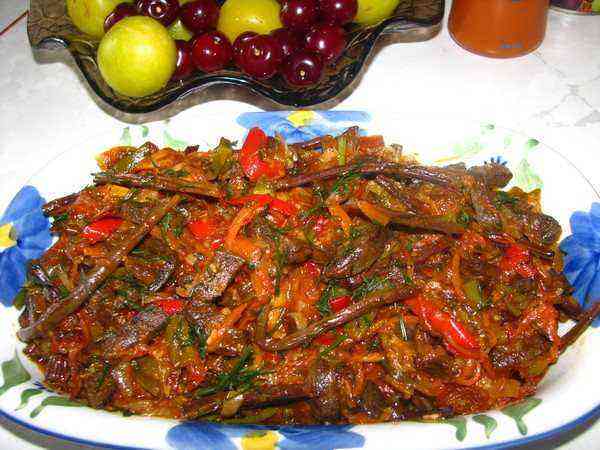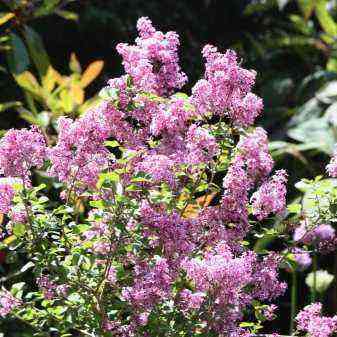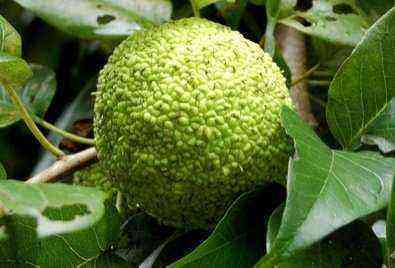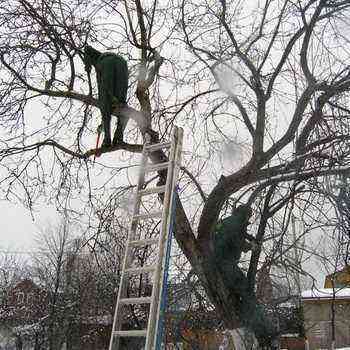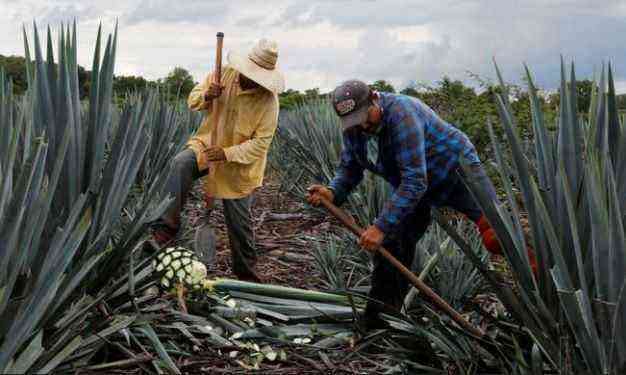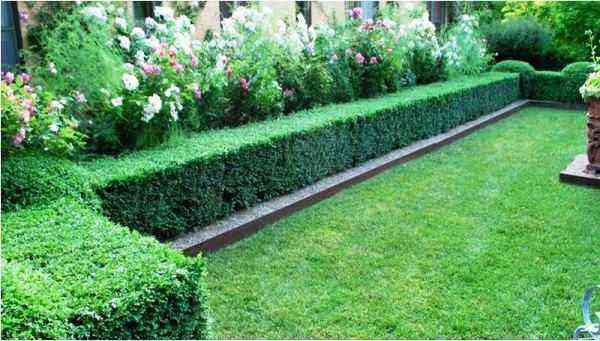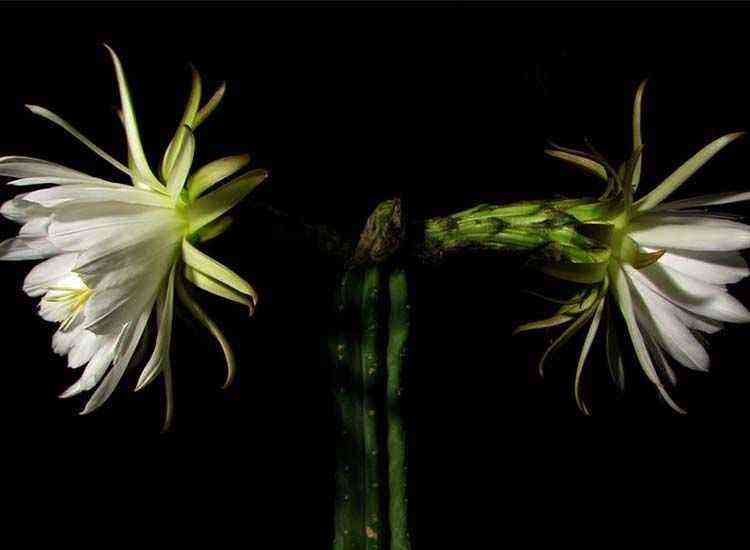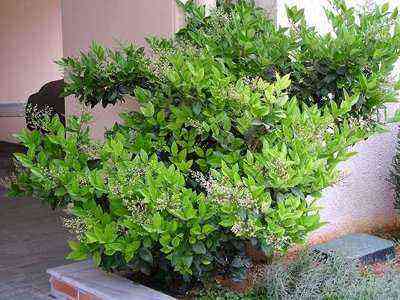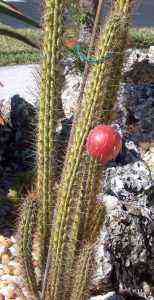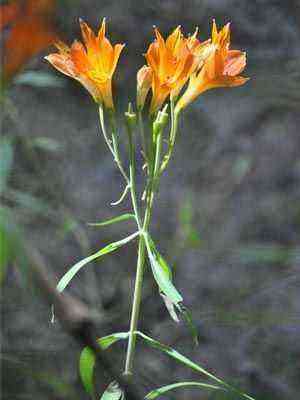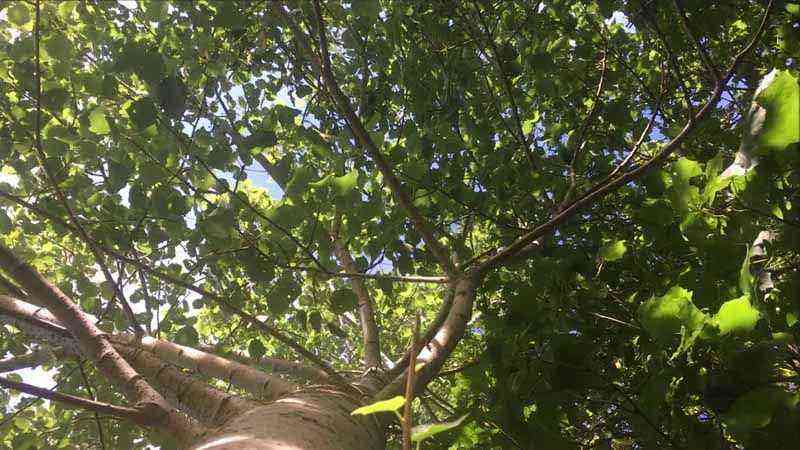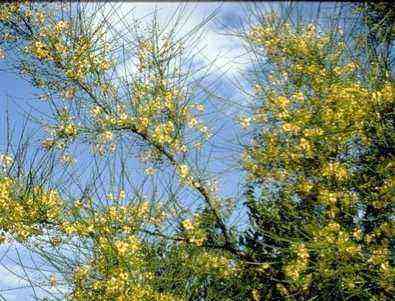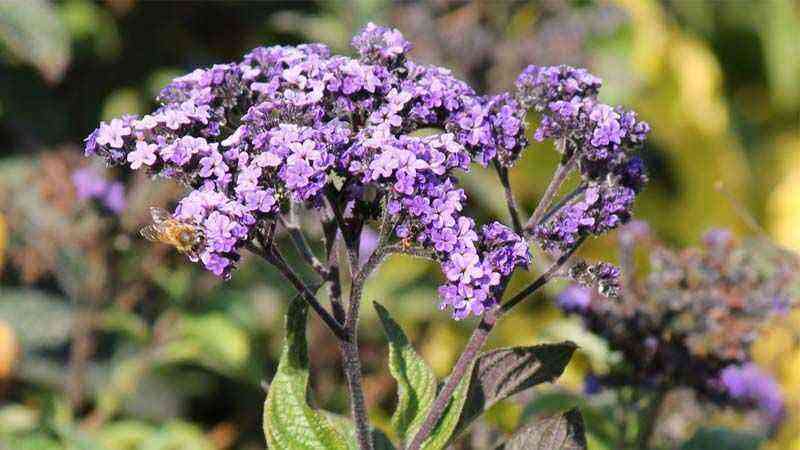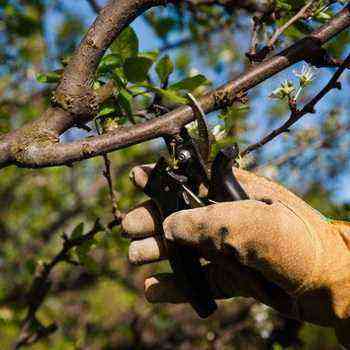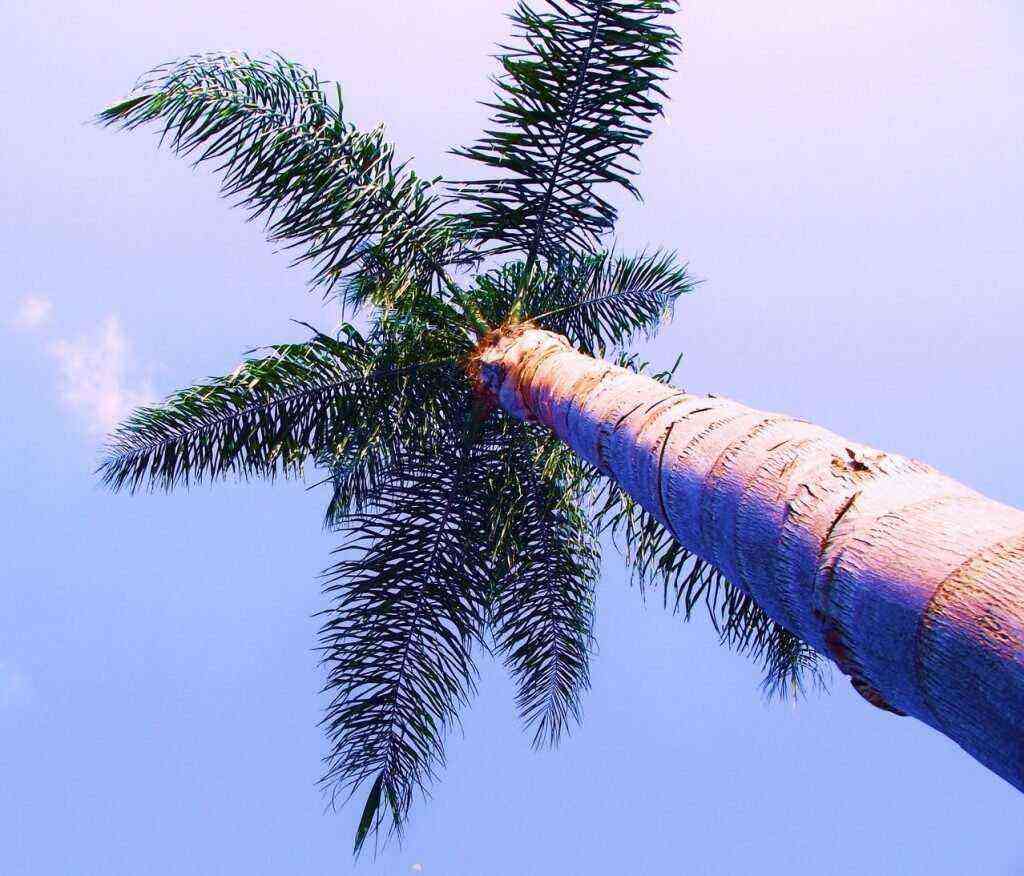The cotoneaster is an ornamental shrub that is loved by many gardeners for its unusual shape, changing color of leaves and brightness of berries. The shrub is most often grown to create a hedge or simply to decorate a garden area. Different types of cotoneaster can be planted singly or form a group planting, which will look very organic. In addition, it is a non-capricious plant that does not need regular and thorough care.
The shrub has no thorns, the berries of most species are not edible, but also not poisonous, which attracts birds. A cotoneaster can decorate any garden, with the help of pruning, you can shape the crown of a plant, make it the shape you like. Also, the bush can grow on one site for more than 50 years and easily tolerates a transplant. Having planted such a bush for the first time, you will definitely want more. There is no need to buy new seedlings, because you can start multiplying the cotoneaster yourself. There are several breeding methods that differ and have both pros and cons. After reviewing them, you can choose the most suitable and convenient for you.
Cotoneaster hedge – beautiful multicolor in autumn and colorful berries in winter
Cotoneaster belongs to the group of shrubs of the Rosaceae family. It is ideal for garden decoration as it has good characteristics, including aesthetic ones. The shrub is perennial, growing and developing over fifty years, reaching a height of two meters – this is important when building a hedge.
The main characteristics of the variety include the following distinctive features:
- foliage, which has a simple geometric shape, elongated, oval. The leaves themselves are quite dense, which allows the plant to keep its shape, take the desired shape. The unique emerald shade of the leaves fits perfectly into any design idea, and evergreen varieties are able to retain their properties even in winter;
- flowers that appear on the plant at the end of May last for about two months. They have a pale pink hue and a pleasant unobtrusive aroma;
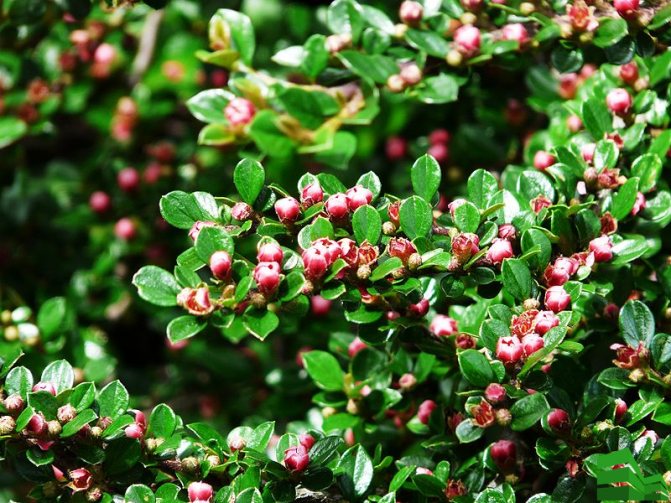
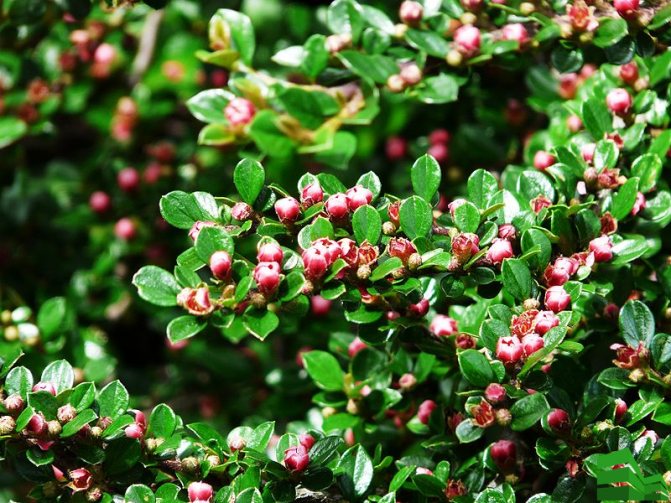
- black round berries, ripening by September, are suitable for medicinal purposes, for making tinctures, ointments. They are unsuitable for food, since they do not have a pronounced taste.
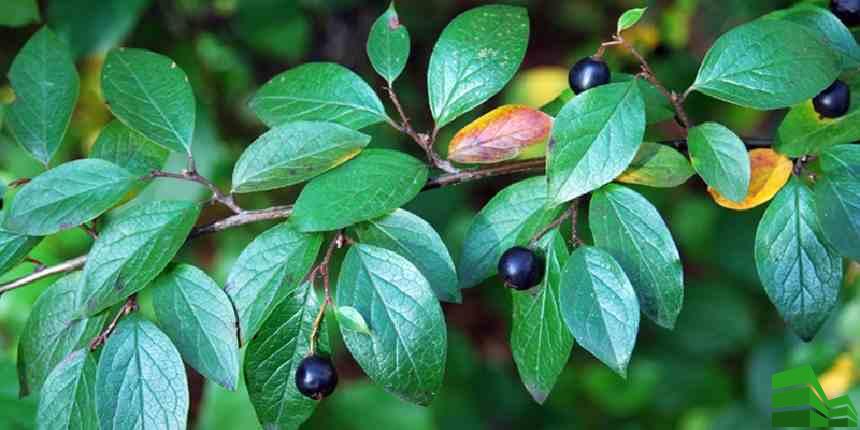
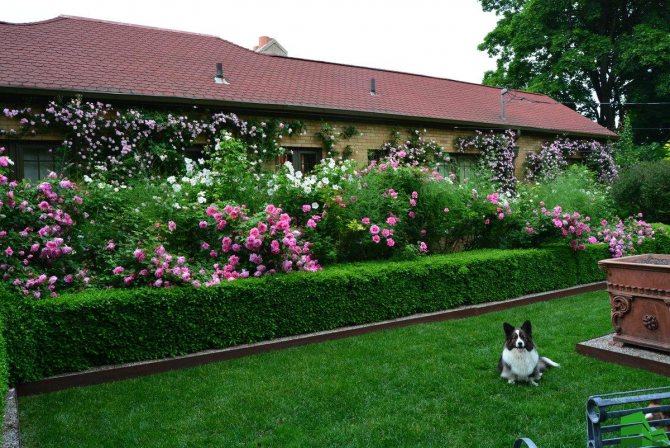
The brilliant cotoneaster is ideal for hedges, while it is unpretentious, it easily gets along with other plants: spirea, rose hips and barberry. In addition, it has a number of distinctive advantages.
Do I need to cover the cotoneaster for the winter
Despite the fact that the cotoneaster is a fairly frost-resistant plant, in the conditions of harsh winters, it is still better to shelter it. For these purposes, dry foliage or peat are well suited (a layer up to 6 cm thick is formed). The branches of bushes that are too high must be bent to the ground, which will help preserve the buds during frost. When the snow falls, you can additionally sprinkle the bushes with it.
As you can see, even taking into account all the nuances of care, growing a brilliant cotoneaster will not create many problems, but with a little effort, you will get the original decor of your site.
Cotoneaster – the benefits of a bush
The cotoneaster goes well with any landscape design solution, suitable for decorating small areas or a whole hedge, wall. Wild flowers or fruit crops can be planted near such a plantation.

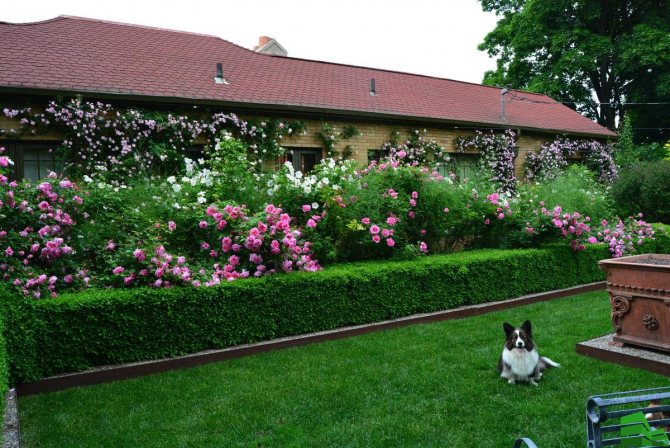
As a shrub, cotoneaster has a number of advantages that attract gardeners to use it for decorative purposes. These include:
- dense foliage of saturated color is the main aesthetic characteristic, since some varieties are able to preserve it in winter frosty time. For this he is appreciated by gardeners around the world;
- simplicity of planting and care, the plant easily adapts to environmental conditions, soil, exists well with other plants. It is able to grow in drought or high humidity conditions, on poor soils, without requiring bait and fertilizers;
- able to grow both in the shade and on the sunny side, while maintaining aesthetic qualities;
- has resistance to insect pests, diseases. But for the purpose of prevention, it is recommended to treat the bushes with an insecticide agent before flowering.
That is why the cotoneaster is used in the improvement of the local area, the construction of a hedge. The only difficulty arising in the cultivation process is the complexity of reproduction, it is required to prepare seedlings with special care, to plant under certain conditions. In addition, the branches need to be trimmed regularly to maintain the desired hedge shape.
Advantages and disadvantages of the species
When breeding a brilliant cotoneaster, it is important to take into account not only the advantages of growing this plant, but also take into account the existing disadvantages. The pluses of the presence of a shiny cotoneaster on your site include the following:
- unpretentious care and neat appearance;
- good resistance to both frost and dry periods;
- almost complete immunity to diseases;
- unpretentiousness in growing conditions (feels great in places of strong air pollution with soot, dust, exhaust gases);
- undemanding to the composition of the soil and the level of illumination of the site.
All this allows you to plant shining cotoneaster seedlings in parks and even on city streets. At the same time, we must not forget about the disadvantages of choosing this particular plant for growing. They include:
- the need for regular pruning of the cotoneaster;
- the relative complexity of reproduction.
Of course, there are much more advantages, so perhaps you should think about buying seedlings.
Cotoneaster hedge – planting
The process of planting a cotoneaster practically does not differ from other bush plants. At the same time, it requires care, accuracy, since this will largely determine the further appearance of the plant, how big and healthy it will become. There is no optimal time for planting, since the plant is unpretentious. It is allowed to plant in the period from spring to autumn, but it should be noted that young shoots should take root before the onset of the first frost. This is necessary for the formation of a sufficient root system, it is she who supplies the plant with useful mineral and nutrients, water, and is responsible for the appearance of the shrub.
It is recommended to plant the plant on a cloudy day. For several weeks after disembarkation, it must be protected from direct sunlight, shaded. This will save young leaves from the appearance of burns, provide a sufficient amount of moisture. It should be planted along a small fence, about a meter high to create a hedge and half a meter for a curb. In this case, you need to follow the following recommendations:
- Determine the place of growth and the intervals between the bushes. To obtain a tall hedge, plant the shoots in one row with an interval of about 30 centimeters. There should be 3-4 seedlings per meter. For curbs, the formula is slightly different: up to 5 seedlings should be placed in one meter of length. This will create a low but dense wall.
- The land for future seedlings needs to be excavated, loosening well, removing bulky clods, weeds.
- In a ratio of 1: 2: 2, mix peat compost, earth and sand – you get a soil for planting, most suitable for young seedlings. It accelerates the process of plant adaptation to new environmental conditions.
- It is recommended to fertilize the planting surface with chalk, this will provide the plant with the necessary minerals. It is made at the rate of 180 grams per square meter of land.
- For seedlings, it is required to prepare pits up to 50 centimeters deep with the same diameter. The bottom should be laid with pebbles or small gravel. This will retain the moisture needed by the plant in the early stages of development.
- More than half of the hole needs to be covered with soil for planting, on top of which the seedling is located. The remaining space can be covered with ordinary soil.
A special soil for planting distinguishes the cotoneaster from other bush, is responsible for the quality and appearance of the plant, its characteristics, properties. Proper planting is the key to the formation of a healthy root system. The plant is gaining strength every day, but it needs to be maintained with regular grooming.
Shiny cotoneaster :: features of planting and caring for a shrub
The brilliant cotoneaster is a rather interesting plant that belongs to the Pink family. It is great for creating hedges, thanks to which it is actively grown in private territories and in parks or squares. In the wild, it can be found in Eastern Siberia, China and Buryatia. The cultivation of a cotoneaster can be safely done in urban conditions, since it is practically immune to dust and gases, frost-resistant and drought-resistant. Let’s find out how to properly plant a brilliant cotoneaster and what kind of care to provide for it so that the plant pleases with its appearance.
Cotoneaster hedge maintenance
The plant is unpretentious, easily adapts to environmental conditions, soil conditions. Nevertheless, it needs care, since this affects the appearance of the shrub, the health of the root system.
Care measures include the following:
- Regular watering. A shrub, especially a recently planted one, needs moisture. It is enough to water the plants abundantly once every two weeks, more often during dry periods.
- Top dressing for the soil – a special composition, which includes mineral and nutritional components responsible for the stable growth, development of the plant, supplying it with oxygen and water. The simplest and most effective option is feeding with urea diluted in water. One bucket with a capacity of 20-30 liters will require one tablespoon.
- Loosening of the soil should be regular, especially in poor, dry soils. This is required to improve the root system, supply it with oxygen and moisture. In this case, it is recommended to clear the surface of weeds.
- Treatment against pests. Most often, the shrub is exposed to aphids and scale insects. Experts advise using tobacco-based fungicides.
- Root protection in winter. This is necessary to keep the plant fresh and green even during frost periods.
A separate issue is pruning branches, which requires regular production, about three times per season. This will allow the composition to maintain its aesthetic appearance, and the plant to grow and develop. No more than a third of the length should be removed at a time. Winter time is not suitable for the procedure.
Brilliant cotoneaster: planting and care, description of varieties
Author: Natalya 09 February 2020 Category: Fruit and berry plants
Brilliant cotoneaster (lat.Cotoneaster lucidus) – a species of shrubs of the Pink family, naturally occurring on river gravels, rocky slopes and in the mixed forests of China and Altai. It is an unpretentious ornamental plant widely used in landscape design. The generic name of the plant is made up of two words, translated as “quince” and “similar, having a form”, and is explained by the similarity of the leaves of the cotoneaster shining with the leaves of the quince. This type of cotoneaster has been cultivated since the XNUMXth century.
Cotoneaster formation
The best shape for forming a cotoneaster is trapezoidal, when the base is wider than the top. This will allow the plant to develop evenly and correctly, each part of it will receive a sufficient amount of sunlight.
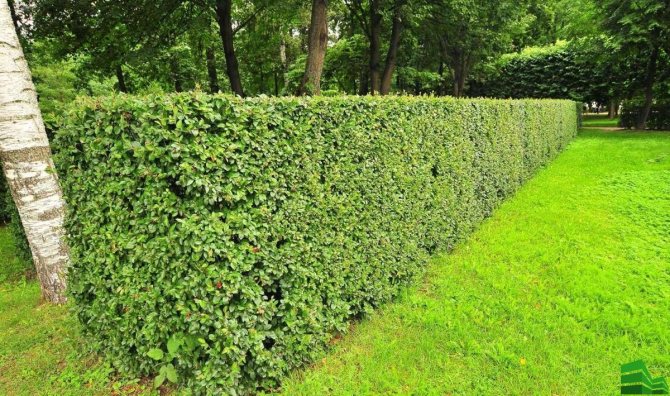
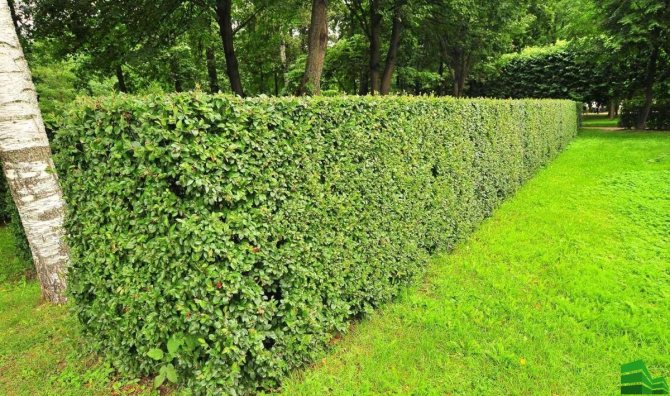
The plant should be pruned 6 to 8 centimeters annually. The procedure is carried out until the shrub reaches the desired height. You don’t have to put much effort in forming a cotoneaster; a novice gardener is able to do it quickly and accurately. When performing work, you will need garden shears and a template – the desired future shape. It is made from wooden blocks connected with a rope.
The most popular form for a cotoneaster is tall, in a row columns. For this, the plant is allowed to run on solid supports. Do not be afraid to prune the plant inaccurately. Rapid growth leaves gardeners the opportunity to correct inaccuracies the next time they adjust the shape.
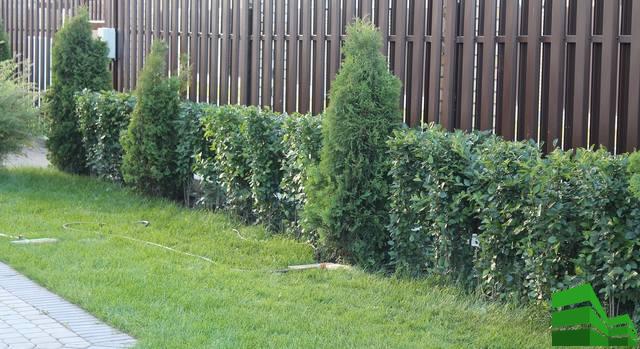
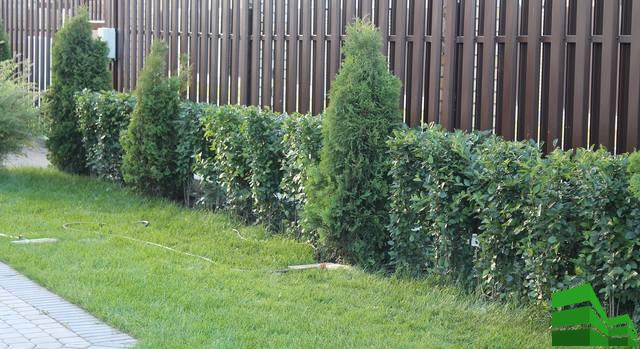
A hedge made using this shrub is able to update any adjacent space, make it unique, inimitable.
Sowing cotoneaster seeds
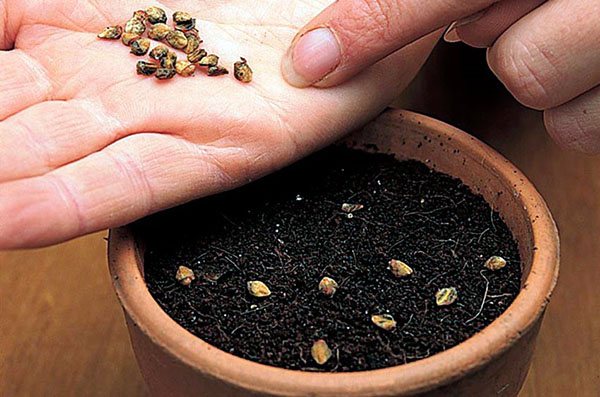
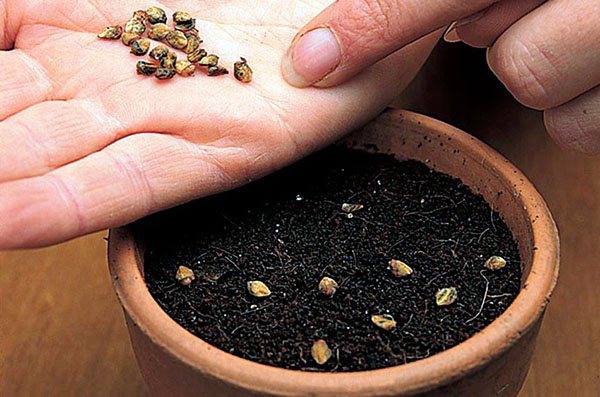
This beautiful shrub bears fruit abundantly with red bead berries, in which the seeds are hidden. Cotoneaster can be propagated by sowing them, but this is not the most productive method. The seeds germinate very poorly, a significant part does not germinate, and the sprouts themselves slowly grow in growth. To get a sapling of sufficient size, you will have to be patient and wait 3-4 years. Cotoneaster propagation by seeds is more often practiced by breeders engaged in obtaining new varieties of plants.
If difficulties are not scary and there is a desire to try this method, then you need to follow these tips:
- First, the berries wither a little. After that, the pulp is much easier to separate from the seeds.
- The refined grains are washed to remove it completely.
- The seeds are rejected in order to separate all unpromising specimens at this stage. This is not difficult to do, it is enough to fill the planting material with water and leave it for a while. Seeds that float on the surface will not sprout, they are immediately thrown away.
- The grains need to be stratified. For two months they are kept at a temperature of 30 ° C, and then gradually it is reduced to -5 ° C.
- The cotoneaster seeds prepared in this way are sown next fall by about 3-5 cm in depth.
The seedlings should be looked after until spring, then planted in open ground. The cotoneaster tolerates shaded areas well. With sufficient lighting, the decorative features of the plant are fully manifested. Therefore, if possible, it is preferable to plant the cotoneaster in an open area.
The hole for planting the plant should be 50x50x50 cm in size. Drainage at the bottom 20 cm high is required so that the roots do not rot. A mixture of peat, humus and sand (all ingredients in 1 volume) and turf (2 volumes) is poured over the drainage. To neutralize the reaction of the soil, you need to mix 250 g of lime.
When planting, it is important to leave enough space between the plants: 50 cm is enough for small varieties, large varieties require about 2 meters.
Diseases and pests of the cotoneaster
The plant has good resistance to many diseases, but there are a few exceptions. Most often, a white bloom is observed on the leaves, they lose their attractiveness, become dull – all these are the consequences of aphids or spider mites. These pests are difficult to pickle, it takes a long time to fight them. If a similar sediment has been noticed on several leaves, it is required to immediately remove them from the shrub and burn them so that the aphid does not spread over the entire surface. The entire plant should be treated with an antimicrobial solution. These recommendations apply to the case of spider mite infestation. The only thing is that when processing with solutions, the concentration must be strictly observed.

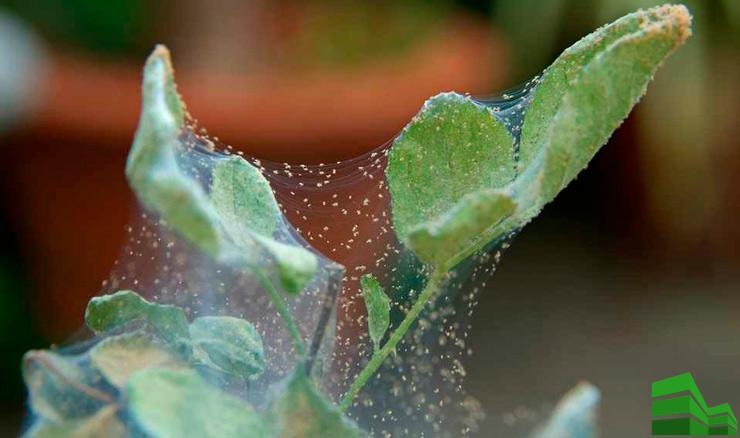
Another common disease is fusarium. It is an infection with a fungus that quickly spreads over the entire surface. Leads to the loss of vitality by the plant, wilting, leaf fall. Treatment for fusarium is based on treating the surface of the bush with specialized chemical solutions, removing damaged areas.
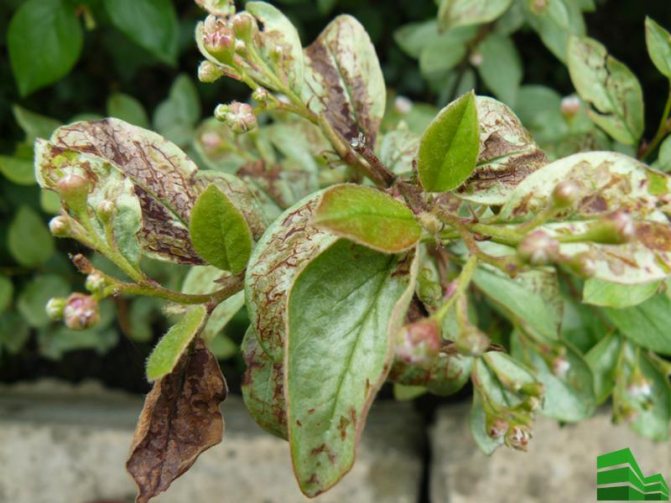
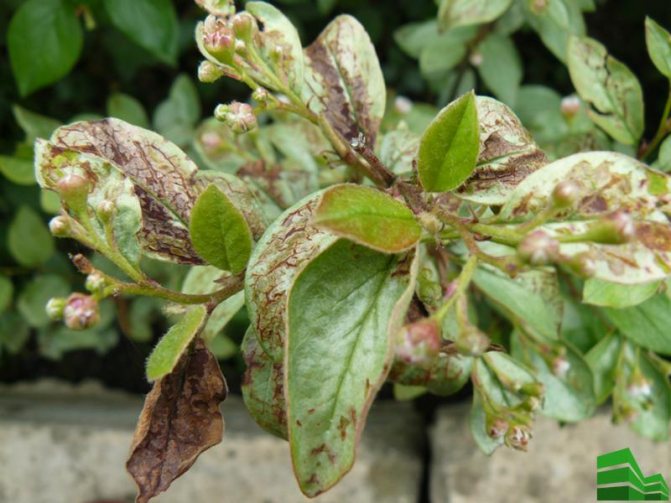
All processing activities should be carried out in cloudy, calm weather. You should take care of your own safety when working with chemical solutions. It is recommended to use rubber gloves, face mask or respirator, eye glasses.
Methods of reproduction
The cultivated brilliant cotoneaster can reproduce in different ways:
- grafting;
- layering children;
- seeds;
- division of the bush.
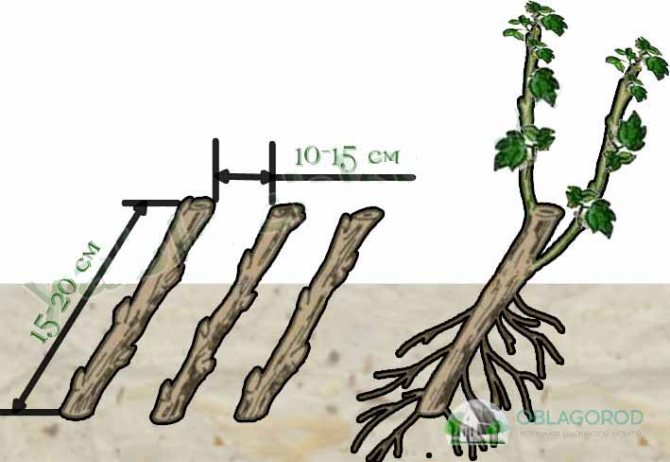

Reproduction by cuttings
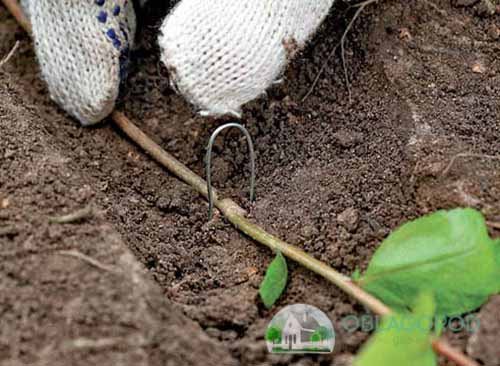
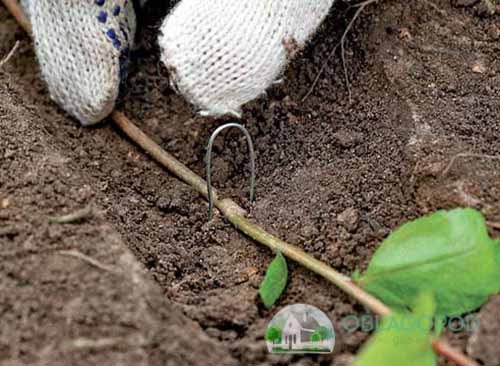
Layers-babies Seeds


By dividing the bush
Each method of reproduction has its own advantages and characteristics, but among inexperienced gardeners and experienced agronomists, the first is most common – cuttings. To form a hedge, you can buy 1 or 2 shrub seedlings, and then plant them in the desired place.
In the second year, you will need to prune them, which will give the bush a beautiful decorative shape. During the cutting process, a large number of twigs will appear, which can be used as a good planting material. This will save you a significant amount of money.
In this case, there are two options for grafting:
- green shoots;
- woody twigs.

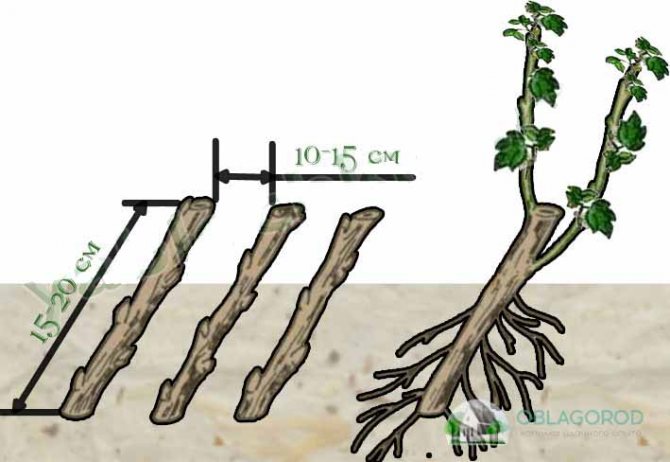
Cutting with woody twigs
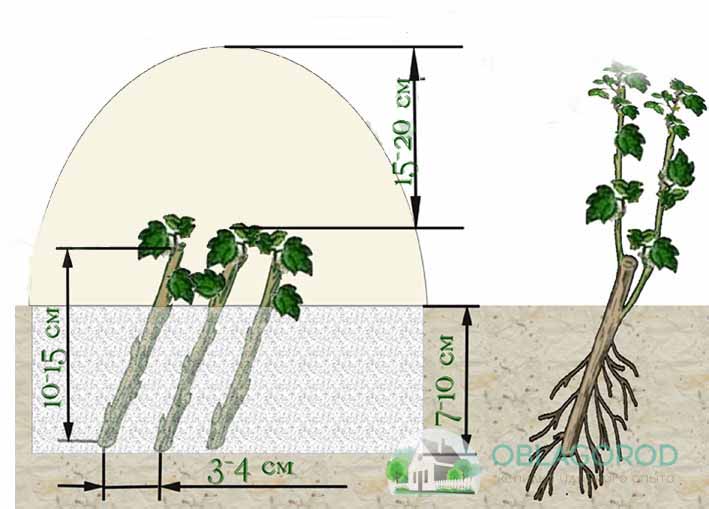
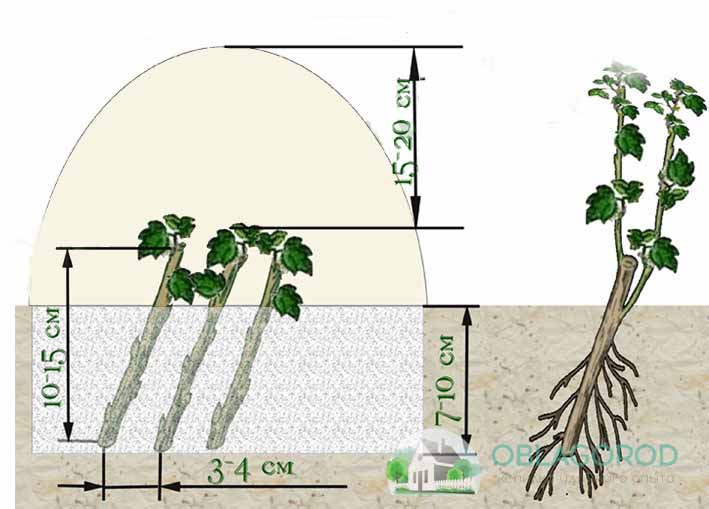
Green shoots
Reproduction by green cuttings is easy to implement and not time consuming. It involves the following actions:
- Only well-bending shoots and twigs are suitable for cuttings, if they are already stiff or very soft, then they cannot be used for this propagation method. Cuttings should be no more than 10-15 cm long and have at least two internodes.
- Cut twigs and shoots should be immersed in a special liquid for a day to stimulate root growth. To do this, they can be treated with a 0,005% solution of the IMC preparation. Another suitable stimulant is heteroauxin, which must be diluted in proportions – 1 tablet to 1 bucket of water.
- For planting, a hole is being prepared, which needs to be additionally fed and fertilized. The stalk should be placed in the ground at an angle of 45 degrees and to a depth of no more than 5 cm. The soil should be loosened beforehand and sand and peat should be added to it.
- After transplanting, the seedling is watered with warm water and covered with a regular plastic water bottle. To do this, you must first cut off the bottom of the bottle. On hot days, the lid must be unscrewed, and watering must also be carried out through it. Another planting option is box planting and placement in a greenhouse or greenhouse.
The most favorable time for the selection of seedlings for cuttings is the beginning of summer – June. In a warm climate, by this month they gain strength, acquire the ability to quickly adapt to the subsequent transplant. Reproduction and planting of seedlings in the middle of summer allows for good rooting, which will allow them to take root in a permanent place.
Reproduction in this way is quite easy to carry out, but the rooting rate of the planting material is from 30 to 95 percent. After rooting, green cuttings get used to the air, so they are subsequently transplanted into open ground.
Layering instructions
The brilliant cotoneaster can also reproduce in another way – by woody cuttings. Such reproduction implies the need to harvest planting material in late autumn or at the very beginning of winter. For storage, you can use boxes of sand, which should be installed in a cool environment. The basement is the best place.
For cutting, twigs with a length of 10 to 20 cm with three to five buds are suitable. In the spring, they take root in the same way as green seedlings. For planting them, a suitable period is the second half of July, and peat and sand can be used as a mixture.
Using cuttings allows you to quickly get a viable shrub
Cutting is the most popular method of propagation, since not all varieties of cotoneaster can reproduce by layering children. At the same time, seed germination is rather low, and the dormant period is very long. Their landing should be carried out with a large margin – before winter. And the use of cuttings allows you to quickly get a viable bush.
Reproduction of the brilliant cotoneaster
Transplanting and propagating a cotoneaster is quite simple. There are two options: using cuttings or seeds. Each method has distinctive features that should be taken into account:
- When grown by seeds, poor germination is observed, more than half does not germinate. They should be stored in a special metal container, in a dark and cool place.
- For propagation by cuttings, both fresh and woody shoots are suitable. They must be at least 15 centimeters high and have at least two shoots.
Planting in both situations is the same, according to the already described scheme. For cuttings, it is recommended to use a growth stimulating solution. This will speed up the process of adapting them to the soil.
A cotoneaster hedge is a good option for decorating a garden plot or a private house, it will delight for many years.
How to plant a shiny cotoneaster in the garden: technology and planting scheme
First of all, it should be noted that the reproduction of the brilliant cotoneaster cannot be called an easy process. It is mainly carried out with seeds, but often also used grafts, cuttings и layers (vegetative propagation).
Seed method
If you have chosen the seed method of cultivating a cotoneaster, then be prepared for the fact that only half of the seedlings will sprout right away and some of them may sprout next year. To increase the germination of seeds, it is better to stratify them throughout the year before planting. To do this, after harvesting in October, the seed is placed in a metal container and sent to storage in a refrigerator or in the open air. Planting is carried out the next year in the fall.
Healthy and full-fledged seeds are placed in the ground to a depth of 4 cm and sprinkled with soil on top. It is also important to observe the distance between the rows: it must be at least 15 cm.
Do not expect quick shoots, because germination of cotoneaster seeds is very difficult, and even with full compliance with all planting conditions and further care, germination often is no more than 20-30%. During the first year, the germinated seedlings grow up to 30 cm in height, and a year later the formation of the crown begins. Flowering occurs no earlier than 4 years later.
Due to the fact that the seeds germinate so poorly, brilliant cotoneaster is very rare in the wild. To increase your chances of success, it is recommended to sow the seeds very thickly. Bushes are transplanted when they are at least 1-2 years old.
Related article: Levkoy: growing from seeds, photos, planting and caring for matthiola
Vegetative reproduction
The most common method of vegetative propagation of the brilliant cotoneaster is propagation by cuttings. For cuttings, green or lignified cuttings are harvested. In any case, the selected specimens must be well developed and large, at least 15 cm long. In addition, at least two internodes must be present on each such part. The best time to complete the procedure is July.
Before planting the cuttings, it is better to place them in a rooting stimulator for several hours, and then plant them in boxes in a pre-prepared substrate. It should consist of humus, turf and sand, taken in equal amounts. Before placing the cuttings in the ground, the soil must be well shed with water. The prepared parts of the plant are placed in the soil at an angle of 45 °, deepening 5 cm into the soil. Then they are covered with glass jars, which must be removed regularly to ventilate the cuttings and water them.
If you decide to use lignified cuttings for reproduction, then you need to cut them off with the onset of frost, after which you need to place the cut parts in the sand and store in a cool place. With the arrival of spring, the cuttings are taken out of the shelter and cut into pieces up to 20 cm long (each such piece should have at least three buds). In the future, rooting occurs in the same way as in the first case.
The shoot itself is placed at a depth of about 10 cm from the surface of the soil, fixed with a metal or wooden bracket and sprinkled with soil mixture prepared according to the specified recipe. The procedure is carried out at the beginning of summer, and in the fall, the layers are cut off from the mother bush and left in the same place until spring. At the beginning of the growing season, the rooted cut can be transplanted.
Description and characteristics of species and varieties of cotoneaster
Cotoneaster and dogwood are completely different plants, which should be immediately understood by a novice gardener. If the dogwood is most often grown for the sake of berries (although the plants themselves are very beautiful), in the cotoneaster the berries are inedible, this is an ornamental plant.
What is a cotoneaster
The wild cotoneaster, belonging to the Rosaceae family, is mainly found in relatively warm regions, both in Eurasia and America. But many species are so hardy that they can be planted in the north of Siberia. In addition, they are distinguished by their extraordinary drought resistance, which is another advantage when using the cotoneaster in ornamental plant growing.
The cotoneaster normally reacts to gas pollution and dust from cities, does not require highly fertile soil, and easily tolerates shading. It practically does not get sick, but sometimes it is attacked by pests. Easily reproduces by all methods known for shrubs.
A shrub can serve as a rootstock for a pear, although in practice this ability is rarely used.
Most cotoneaster species grow in the form of low bushes, almost all shed their foliage for the winter, but there are also evergreen varieties. Very durable: over 50 years of growth. Bushes can be erect or creeping, they are densely covered with small leaves, usually ovoid, dark green in color, sometimes with stripes or patterns. In the fall, the foliage gradually turns red, so the cotoneaster is beautiful at this time of the year.
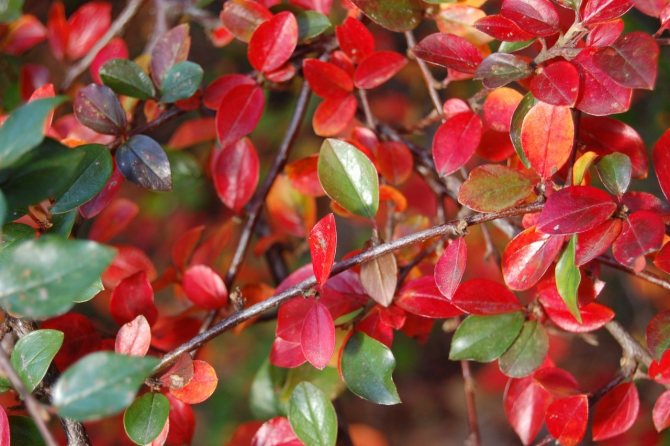
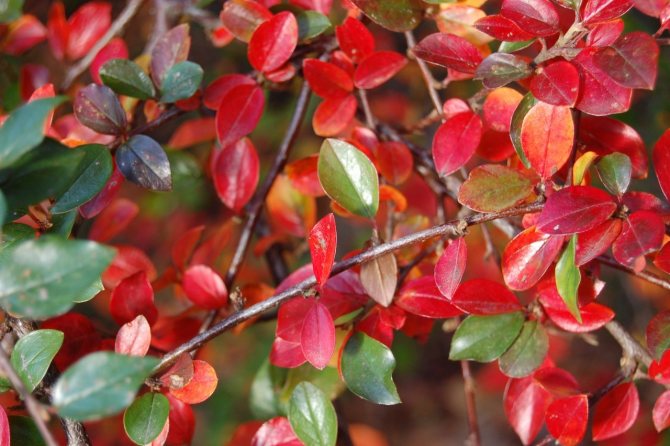
In the autumn, red leaves begin to appear on the bushes, and later they all turn purple
Inflorescences, raceme or corymbose, contain many small flowers, in most cases – white or pink. The fruits are apple-shaped, small, at first they have a green color, and in the process of ripening they become orange, red or almost black: the color of the fruits depends on the type and variety of cotoneaster. The fruits are not poisonous, but people are not used for food, and birds feed on them. Contain several seeds. The roots of the cotoneaster are located close to the surface, they are highly developed, the branching of the roots is used to strengthen the slopes, uneven relief.
Types of cotoneaster
There are many types of cotoneaster, but within each species the number of varieties is small. For example, in the State Register of the Russian Federation there is generally no section dedicated to this culture. The greatest frost resistance and pickiness, allowing them to be used in most regions of our country, are characterized by three types: brilliant, black-fruited and whole-edged cotoneaster. The horizontal cotoneaster, willow cotoneaster and Dammer’s cotoneaster are also of great interest.
Cotoneaster shiny
Cotoneaster shining in the wild grows in the east of Siberia, is one of the most common species in the cities of our country. It can grow up to two meters in height. In the wild, it can grow both in the form of thickets and in lonely standing bushes. Leaves, up to 5 cm in size, fall off for the winter. The flowers are pink in color. Blooms in May-June. Ripe black fruits.

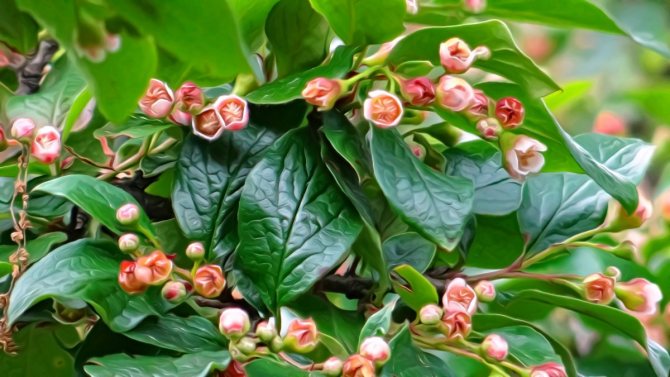
The brilliant cotoneaster is best known in our country.
The brilliant cotoneaster is planted not only to decorate garden and park areas. Often it is placed on the side of the road: it does not react at all to gas pollution, it is extremely unpretentious to weather conditions. In autumn, the leaves turn purple. The fruits are edible, but tasteless, therefore they are not used in cooking.
Black cotoneaster
The black cotoneaster also grows up to about two meters in height and endures unfavorable weather conditions. The underside of the ovate leaf is covered with pubescence, so are the young shoots. Flowers are pink, collected in inflorescences up to 15 pieces. Fruits up to 1 cm in size outwardly very much resemble the fruits of black chokeberry, ripen in early September. They are edible, but not of interest as fruits or berries, but they are widely used in folk medicine. However, all parts of the plant have medical applications.
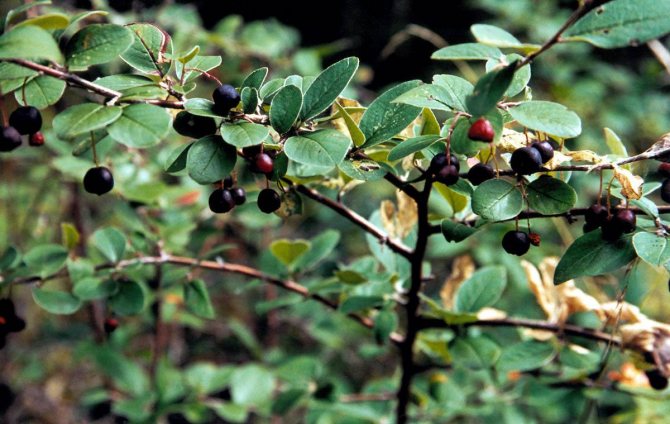
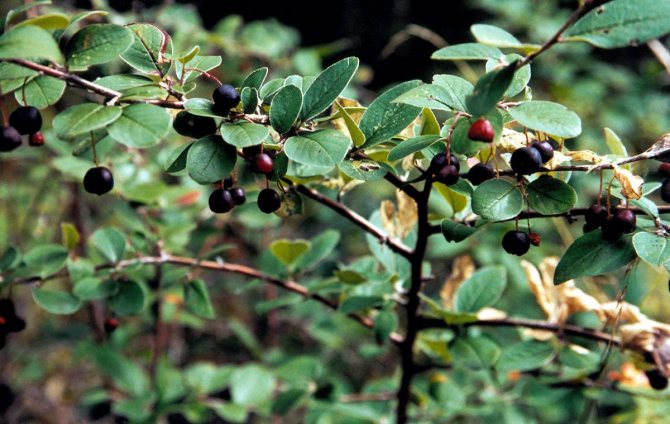
The fruits of the cotoneaster are easy to mistake for the fruits of the chokeberry.
Common cotoneaster (all-edge)
The ordinary cotoneaster grows up to two meters. Annual shoots are pubescent, but later become smooth. Leaves are from oval to almost round, dull, reaching 5 cm. From below, they appear whitish, because they are abundantly pubescent. There are only a few flowers in the inflorescences, the shrub blooms in early spring. The fruits are round, bright red in color. In the wild, this cotoneaster grows in Western Europe, as well as in the Caucasus, but for several centuries it has been used for landscaping urban areas.

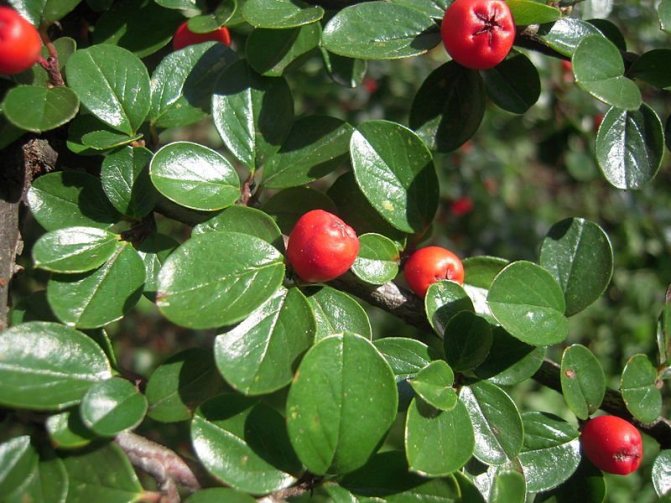
The common cotoneaster began to be used earlier than others for landscaping.
Horizontal cotoneaster
The horizontal cotoneaster is an inhabitant of the mountains of China. The bushes are very low, up to half a meter. The leaves are dark green, with a strong sheen, the foliage is high. By autumn, the leaves turn red, by winter they fall off. The shrub blooms with pink-red flowers, the fruits are red, up to 5 mm in size, they stay on the branches for several months. The varieties of this cotoneaster were bred: Variegatus, Perpusillus and Saxatilis, differing in the size of the bush and leaves.
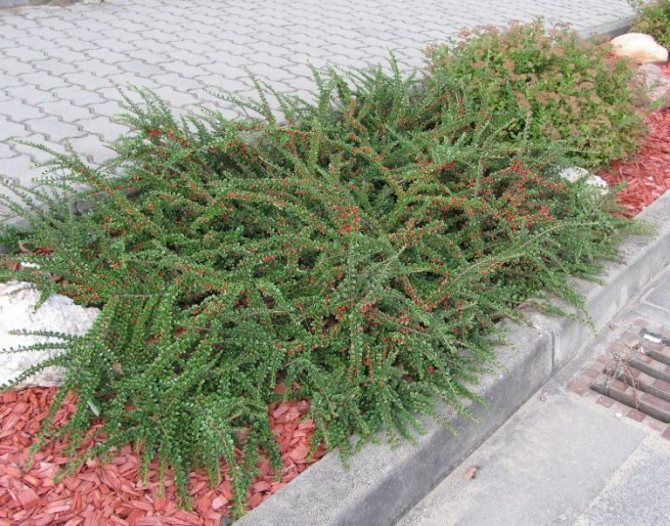

Horizontal cotoneaster – the most famous representative of low-growing species
Dammer’s cotoneaster
Dammer’s cotoneaster is a tiny plant, up to 30 cm high, but one bush can spread its creeping shoots up to a meter in different directions. Dark green leaves are very dense, small, melliferous flowers, but seemingly uninteresting. The shrub takes on particular beauty during the ripening of the fruit. They are coral red in color and hang from branches all winter. This cotoneaster also has varieties: Coral Beauty, Eichholz, Cardinal and Stogholm, differing in the size of the bush and, slightly, in the color of the flowers.

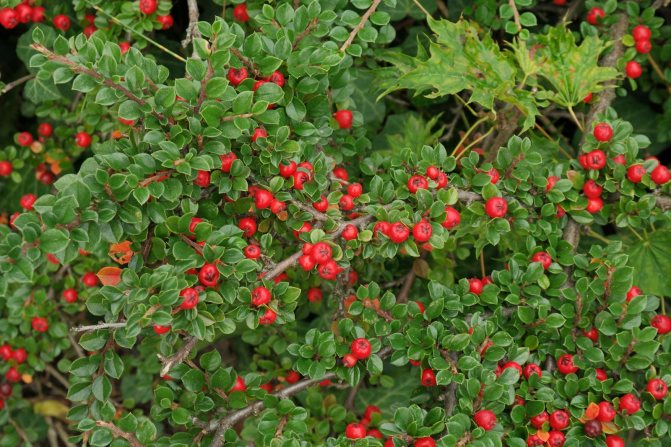
Dammer’s cotoneaster bears fruit of a very beautiful color
Willow cotoneaster
The willow cotoneaster, like Dammera, is also distinguished by creeping shoots that are close to the ground. As a result, the bush, which is no more than half a meter in height, spreads over two meters in width. Unlike most species, willow leaves do not shed their foliage for the winter. The flowers in the clusters are white, the fruits are red, they hang on the bushes all winter.
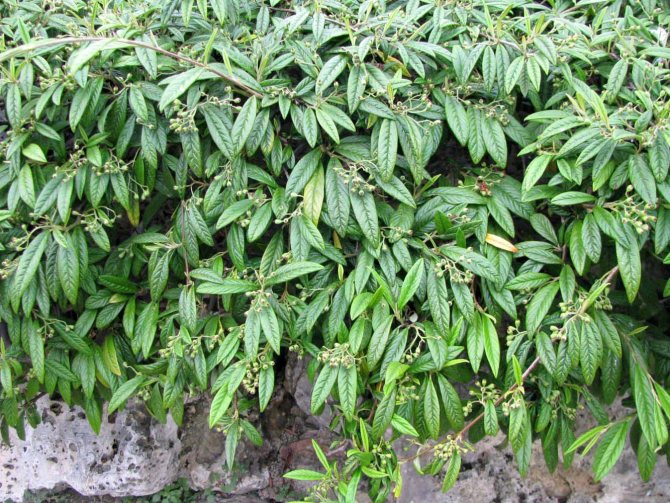
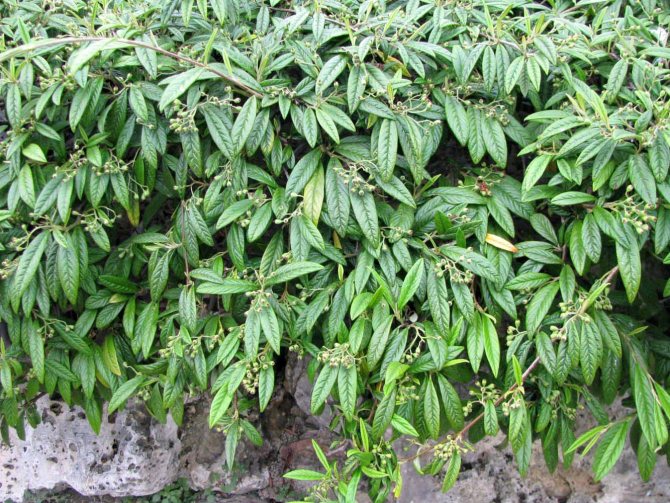
Willow cotoneaster – a representative of evergreen cotoneaster
Other types
Other types of this plant are much less widespread in our country:
- brush-colored (grows in the form of a tree up to 3 meters high, blooms with pale pink flowers, the fruits are bright red in color);
- multi-flowered (shrub grows up to 3 meters, blooms profusely and bears fruit, but much less frost-resistant than other species);
- small-leaved (evergreen miniature shrub with white flowers and orange-red fruits);
- felt (bush up to 1,5 meters high, branches with strong pubescence, pink flowers);
- spread out (spreading bush up to one and a half meters high, with bright red fruits, very hardy).
In total, more than fifty species and varieties are known, and all of them are cultivated to one degree or another and are widely used in landscape design, for the purpose of landscaping and decorating cities.
The use of a cotoneaster in garden landscaping
An ornamental shrub is quite common in gardens. The culture looks harmonious in any garden composition. Dense branching and unpretentious care make the plant indispensable for creating low curbs and a living fence. The green fence can withstand any conditions, so the cotoneaster is used to decorate not only suburban areas, but also squares, park zones and highways in cities.

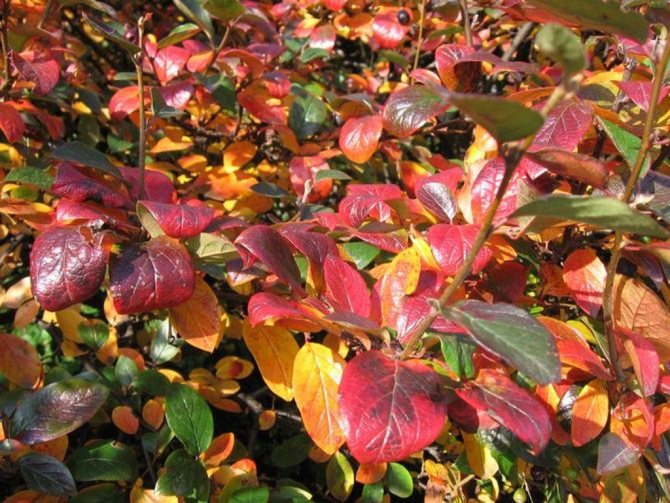
The genus of cotoneaster has more than 40 species, of which about ten are now used in landscape design – this is an ordinary cotoneaster, horizontal, shiny.
The cotoneaster is one of the few representatives of the flora used to strengthen the soil. On corroded soil, the plant grows rapidly, holds the soil together and prevents its further destruction. In landscape design, crops are planted to strengthen coastal areas and slopes.


Shiny cotoneaster – a large deciduous bush, strewn with smooth leaves of rich green color, lush inflorescences and fruiting inedible, but beautiful dark berries.
Due to its slow growth, the shrub is suitable for creating a topiary haircut. The plant is given a variety of shapes, ranging from simple balls to complex geometric shapes. Subject to certain rules, giving the desired shape is not difficult.
Low-growing varieties are ideal for forming a shrub lawn. It perfectly masks problem areas of the garden and is a good substitute for ordinary grassy cover.
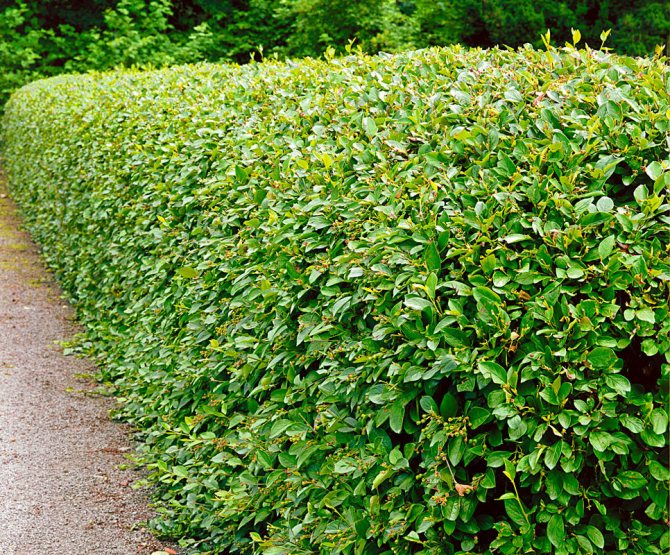
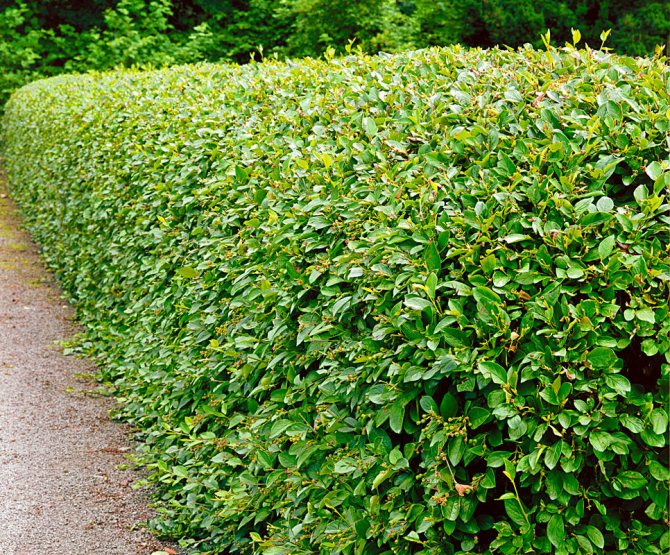
It tolerates pruning well and grows slowly, which serves as an excellent basis for using it as a decorative landscape decoration.
Brilliant cotoneaster is a versatile plant, it looks spectacular both in single and in group planting. The variety of sizes and shapes allows you to use culture to create any composition. And this is not surprising, because the genus Cotoneaster consists of low-lying and erect varieties of various sizes and colors of leaves and fruits. In addition, white and pale pink flowers give a special beauty to the space, and the ability of the leaves to change the shade effectively dilutes the usual landscape during the fall.
In group compositions, the plant is combined with representatives of conifers. Low species are used in rockeries and rock gardens. The cotoneaster goes well with stone and other garden compositions.
For reference! Due to its frost resistance and the ability to grow in one place for a long time, the cotoneaster hedge retains its decorative effect at any time of the year.
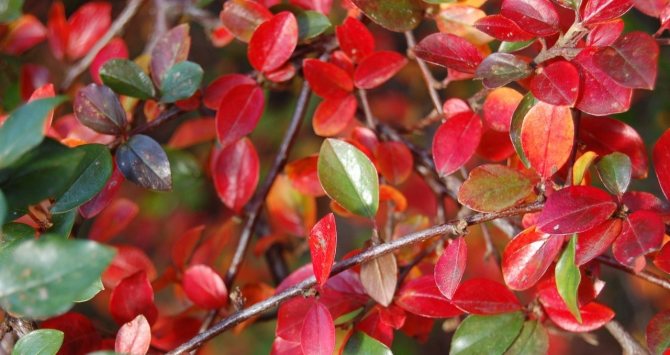
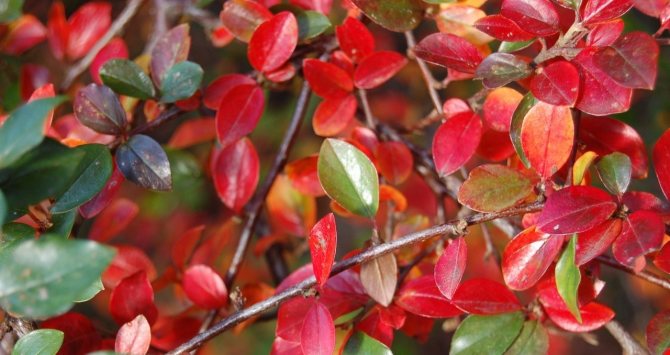
In the fall, foliage changes color, delighting gardeners with a wide range of reds and purples with orange and yellow flashes.
